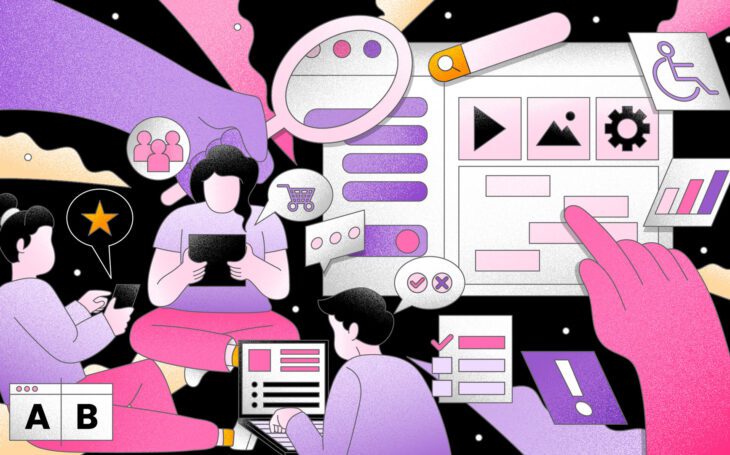🎁 Free 30-day publishing fees on Pay-As-You-GO. Get 15% off when recruiting from the UserQ Panel, with code HELLO15
Understanding the difference between user testing vs usability testing

User testing vs usability testing: the names may sound similar, but there’s a very big difference between the two. This guide provides a detailed overview of both, explores use cases, compares their performance, and highlights when to use each.
Both user testing and usability testing uncover insights directly from users, playing a crucial role in shaping the success of a business. While user testing focuses broadly on understanding user needs and validating ideas, usability testing zooms in on ensuring that specific functionalities and interfaces are user-friendly.
Let’s dive into their distinctions, practical applications, and how tools like UserQ can make a difference.
The importance of user testing in business success
Understanding users is at the heart of building a successful product or service. User testing allows businesses to uncover their target audience’s needs, pain points, and preferences, helping align offerings with market demands. This discovery process not only aids in prioritising features but also plays a pivotal role in improving conversion rates, customer satisfaction, and overall user engagement.
Testing tools like UserQ provide researchers with actionable insights to fine-tune products and address user feedback effectively. With the right tools, businesses can make data-driven decisions to stand out in competitive markets.
What is user testing?
User testing is a form of discovery research that helps businesses validate their ideas by understanding whether their target audience would be interested in a product or service. It focuses on user needs, desires, and behaviours.
Common types of user testing:
- A/B testing: Comparing two variations to identify which performs better.
- Feedback surveys: Gathering quantitative insights about user preferences.
- Focus groups: Discussing concepts or prototypes with selected groups.
- Interviews: Conducting in-depth conversations to explore user opinions.
This method is highly versatile and can be employed at different stages of the product development cycle to validate ideas and ensure market alignment.
What is usability testing?
Usability testing, on the other hand, assesses the usability of a product, ensuring it is user-friendly and that features work as intended. This type of testing evaluates how users interact with a product or interface and whether they can achieve specific tasks with ease.
Common types of usability testing:
Most usability testing methods involve getting participants to engage with your product and perform certain tasks (for example, an online shop, testing its website might ask participants to create a personal account or browse products).
- Moderated testing: A researcher observes and interacts with participants in real-time.
- Unmoderated testing: Participants complete tasks independently, with results analyzed afterward.
Focus areas of usability testing:
- Visual interface and appearance: Ensuring the interface is intuitive and aesthetically pleasing.
- Efficiency and findability: Measuring how easily users complete tasks or locate information.
- Content clarity: Evaluating if content is understandable and appropriately styled.
- Accessibility: Ensuring inclusivity for users with disabilities by complying with WCAG guidelines.
Accessibility testing, a subset of usability testing, involves tools and real-user feedback to identify barriers for users with impairments.
Key differences between user testing and usability testing
To better understand usability vs user testing, here’s a detailed comparison:
Aspect | User Testing | Usability Testing |
Purpose | Broadly explores user needs and preferences. | Evaluates how users interact with a product. |
Stage of Development | Conducted at any stage, from ideation to launch. | Requires at least a low-fidelity prototype. |
Methods | Surveys, interviews, focus groups, etc. | Moderated or unmoderated tasks, heuristic evaluation. |
Outcome | Understand user behaviour and market fit. | Diagnose usability issues and improve efficiency. |
When to use user testing vs usability testing
The difference between user testing and usability testing becomes evident when considering the stage and purpose of testing. Use user testing to explore your audience’s feelings and opinions, and use usability testing to refine specific aspects of a prototype or product.
For example:
- At the concept stage, use feedback surveys to gauge interest.
- When validating a feature, conduct A/B testing or focus groups.
- If optimising a prototype, rely on usability testing tools to spot issues.
UserQ combines usability testing and user testing tools into a streamlined platform, helping businesses address regional needs while staying cost-effective.
Get started with our UserQ platform
What UserQ tool you use really comes down to what you intend to do with the data and info you collect. We’ve got seven unique tools – each providing actionable insights for researchers, like you.
Create tests with pay-as-you-go pricing (never pay for what you don’t use) and access over 10,000 MENA participants with our UserQ panel – covering 10+ demographic filters. Best of all, you can test in both English and Arabic to reach people in their desired language.
Still not sure if UserQ is the tool for you? See how we compare to other leading UX research platforms out there.
Get started with UserQ today to leverage powerful insights and elevate your product development process with a MENA-specific approach to testing.
Related Post

The benefits of user research
User research is typically a key part of product development and business growth all around the world, but here at

Best practices for conducting remote
In this guide, we’ll let you in on UserQ’s top tips and tricks to utilise our selection of remote user

Start, Grow, Lead: A Guide
A career in which you can make a real difference to the everyday lives of customers and clients alike is
Subscribe to our
product newsletter!
Receive emails about UserQ updates, new features,
offers and latest trends.


